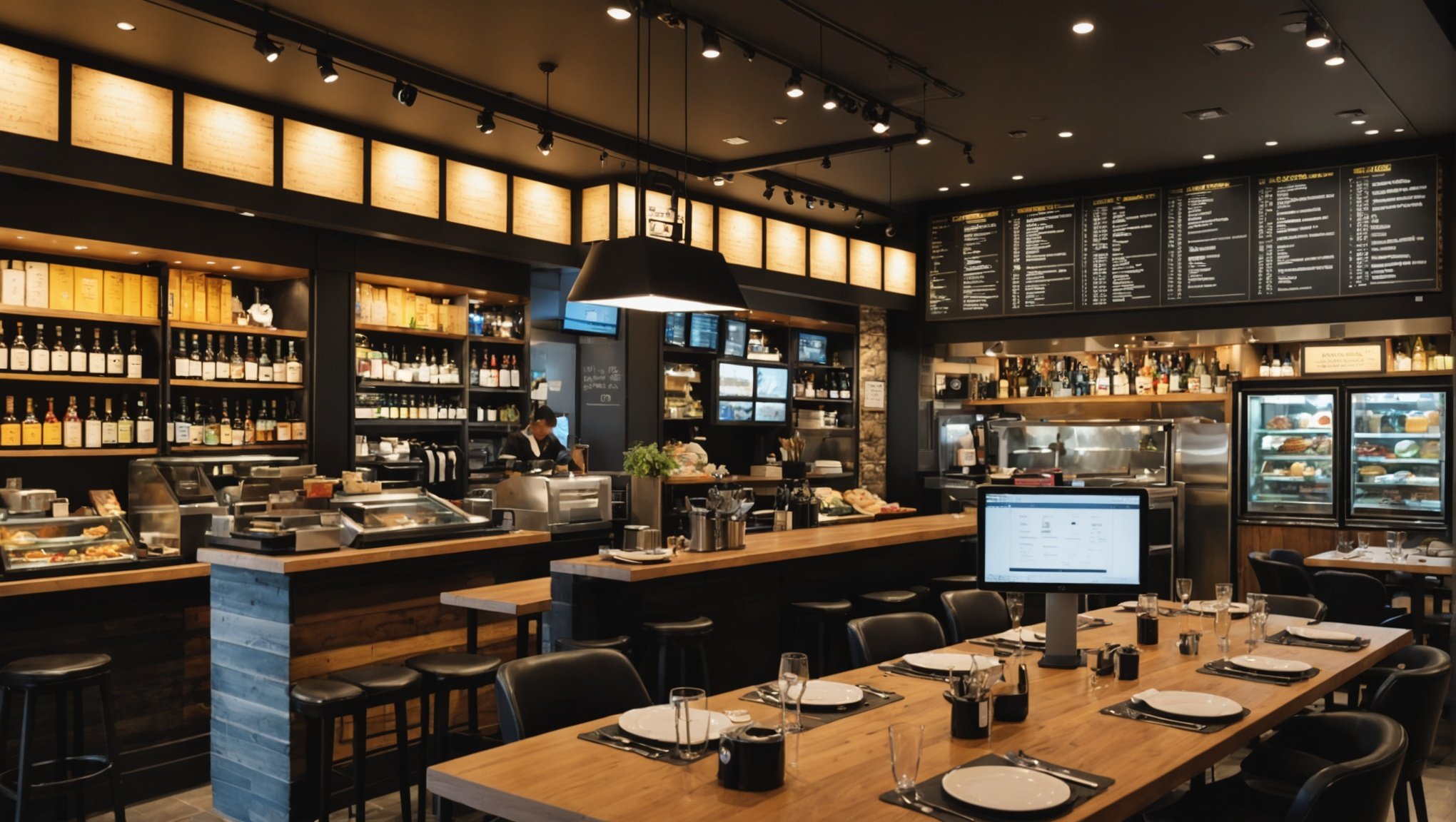Efficient inventory management is a game-changer for multi-location restaurants. With rising costs and complex logistics, the pressure to maintain optimal stock levels intensifies. IoT devices offer innovative solutions, streamlining processes and providing real-time data. These technologies not only reduce waste but also enhance decision-making. Explore how integrating IoT can transform inventory management, creating a seamless experience across various locations and driving profitability.
Overview of IoT in Inventory Management
Understanding the integration of IoT technology in inventory management is vital for modern restaurant operations. The Internet of Things (IoT) refers to interconnected devices that communicate and exchange data, enhancing efficiency and accuracy in tracking inventory levels. This technological advancement is crucial for restaurants aiming to streamline their operations and reduce wastage.
Also read : Top strategies for safely handling fresh produce in commercial kitchens
Current Trends
The adoption of IoT technology in the restaurant industry is on the rise. Many establishments are leveraging smart sensors and automated systems to monitor stock levels in real-time. This trend helps in minimizing human errors and optimizing order processes. It’s particularly beneficial for restaurants with multiple locations, where maintaining consistent inventory can be challenging.
Multi-Location Challenges
Managing inventory across various locations presents unique challenges. IoT solutions offer a way to mitigate these issues by providing centralized data access, enabling managers to oversee stock levels remotely. This ensures that each location is adequately supplied, enhancing overall restaurant operations.
Have you seen this : Ultimate guide to preserving ice cream freshness: pro tips to avoid freezer burn in your dessert bar
- Real-time monitoring: Ensures accurate stock levels
- Centralized data: Facilitates multi-location management
- Reduced wastage: Optimizes inventory usage
The integration of IoT technology in inventory management is not just a trend but a transformative approach that enhances efficiency and reliability in restaurant operations.
Benefits of Implementing IoT for Multi-Location Restaurants
Exploring the benefits of IoT in multi-location restaurants reveals significant improvements in operations.
Enhanced Visibility and Real-Time Tracking
With IoT, restaurants gain enhanced visibility into inventory, allowing for real-time tracking. This ensures managers can monitor stock levels across all locations instantly, reducing discrepancies. Enhanced visibility aids in making informed decisions swiftly, thereby increasing operational efficiency.
Cost Savings Through Reduced Waste
IoT technology contributes to cost reduction by minimizing waste. Automated alerts for low-stock or expiration dates enable timely actions, preventing overstocking or spoilage. This precision in inventory management translates into substantial cost savings, optimizing resource allocation.
Streamlined Operations Across Locations
For multi-location establishments, IoT facilitates streamlined operations. By centralizing data, managers can coordinate orders and supply chains more effectively. This uniformity ensures consistent service quality and resource distribution across all outlets.
- Real-time inventory updates
- Automated alerts for stock levels
- Centralized data management
Implementing IoT not only enhances operational efficiency but also ensures a consistent and reliable service model, essential for multi-location success. The benefits of IoT extend beyond simple tracking, offering a comprehensive solution for modern restaurant challenges.
Key IoT Devices for Inventory Management
Exploring essential tools for efficient inventory tracking in restaurants.
Smart Sensors and RFID Technology
Smart sensors and RFID technology are pivotal in modern restaurant technology. These devices track inventory by providing real-time data on stock levels. Smart sensors detect changes in temperature and humidity, ensuring optimal storage conditions. Meanwhile, RFID tags enable precise inventory tracking, reducing human error.
Automated Ordering Systems
Implementing automated ordering systems significantly boosts efficiency. These systems automatically reorder stock when levels drop below a set threshold, ensuring a steady supply of ingredients. By integrating with existing restaurant management systems, they streamline operations and reduce manual workload.
Integration with Restaurant Management Systems
The seamless integration of IoT devices with restaurant management systems is crucial. This connectivity allows for centralized data management, enhancing decision-making processes. Managers can access inventory data remotely, ensuring consistent stock levels across all locations.
- Smart sensors for environmental monitoring
- RFID technology for precise tracking
- Automated ordering systems for efficiency
- Integration with restaurant management systems
Utilizing these IoT devices not only optimizes inventory tracking but also aligns with the broader goals of modern restaurant technology. This integration ensures enhanced operational efficiency and improved service quality.
Case Studies of Successful IoT Implementation
Exploring practical applications and outcomes in the restaurant industry.
Multi-Location Restaurant Success
A prominent multi-location restaurant chain successfully utilized IoT technology to revolutionize its inventory management. By implementing smart sensors and automated systems, they reduced wastage by 30% and improved stock accuracy by 25%. This case study highlights the potential of IoT in transforming traditional operations into efficient, data-driven processes.
Lessons from Early Adopters
Early adopters of IoT technology provide valuable insights into its implementation. These pioneers faced challenges such as initial setup costs and training staff on new systems. However, the long-term benefits, including enhanced efficiency and reduced human error, outweighed these hurdles. Their experiences underscore the importance of strategic planning and phased integration for successful IoT adoption.
Key Metrics of Impact
The impact of IoT on inventory efficiency is evident through key metrics:
- 30% reduction in wastage
- 25% improvement in stock accuracy
- 20% increase in operational efficiency
These metrics demonstrate the tangible benefits of IoT, showcasing its role as a transformative tool for inventory management. By analyzing these case studies, restaurants can gain valuable insights into the practical applications and measurable outcomes of adopting IoT solutions, paving the way for improved efficiency and sustainability.
Best Practices for IoT Integration in Restaurants
Implementing IoT technology efficiently in your restaurant operations.
Assess Current Inventory Management Systems
Before integrating IoT technology, assess your current inventory management systems. Identify areas where technology can enhance efficiency and accuracy. Evaluate existing processes to determine the gaps that IoT can fill. This assessment helps in understanding the specific needs of your restaurant, ensuring a targeted approach to IoT integration.
Select the Right IoT Devices
Choosing the appropriate IoT devices is crucial for effective integration. Consider factors like the size of your restaurant, the complexity of operations, and budget constraints. Devices should align with your specific needs, whether it’s real-time tracking or automated ordering. A strategic selection ensures that the technology supports and enhances your restaurant management efforts.
Train Staff for Adaptation
Training staff is essential for smooth IoT integration. Employees should be familiar with new technologies and processes to maximize benefits. Conduct workshops and provide resources to help them adapt. This not only boosts confidence but also ensures that the transition to IoT is seamless and effective.
- Evaluate current systems
- Select suitable IoT devices
- Conduct staff training sessions
Implementing these best practices will facilitate a successful IoT transition, optimizing your restaurant’s operations and inventory management.
Potential Challenges and Solutions
Navigating the challenges of IoT implementation in multi-location settings can be complex. However, understanding these hurdles and employing effective troubleshooting strategies can ensure a smoother transition.
Common Hurdles
Adopting IoT technology often presents obstacles such as connectivity issues and device compatibility. These can disrupt operations, particularly in multi-location restaurants where consistent performance is critical.
- Connectivity issues
- Device compatibility
- Interference with existing systems
Data Privacy Concerns
Data privacy is a significant concern in IoT implementation. Restaurants must ensure that customer and operational data are protected from breaches. Implementing robust encryption and access controls can mitigate these risks.
“Data privacy is not just a regulatory requirement but a trust-building measure.”
Solutions for Device Reliability
Maintaining device reliability is crucial for effective IoT implementation. Regular maintenance and software updates are essential to prevent malfunctions. Additionally, investing in high-quality devices can reduce the need for frequent troubleshooting.
- Regular maintenance
- Software updates
- Quality device investment
By addressing these challenges with proactive solutions, restaurants can harness the full potential of IoT, enhancing efficiency and security across their operations.
Comparative Analysis of IoT Technologies
Exploring diverse options for effective inventory management in restaurants
Overview of IoT Technologies
Different IoT technologies offer unique applications for inventory management. Smart sensors provide real-time insights into stock levels, while RFID technology ensures precise tracking. Automated ordering systems streamline supply processes, reducing manual intervention.
Pros and Cons for Multi-Location Restaurants
Each IoT technology has distinct advantages and limitations. Smart sensors are excellent for monitoring environmental conditions but may require regular maintenance. RFID technology offers high accuracy but can be expensive to implement. Automated systems enhance efficiency but might face integration challenges with existing systems.
- Smart sensors: Accurate monitoring, maintenance needs
- RFID technology: High precision, cost-intensive
- Automated systems: Streamlined operations, integration issues
Recommendations for Best Technology
Selecting the right IoT technology depends on specific operational needs. For restaurants prioritizing accuracy, RFID technology is recommended. If cost is a concern, smart sensors may be more suitable. Automated systems are ideal for those seeking operational efficiency across multiple locations.
“Choosing the right technology is about aligning with your restaurant’s unique challenges and goals.”
By evaluating these options, restaurants can make informed decisions, optimizing their inventory management and overall efficiency.
Actionable Insights for Restaurant Managers
Enhance your restaurant’s efficiency with strategic IoT investments.
Budgeting and Planning for IoT Investments
When considering IoT strategies, effective budgeting is crucial. Allocate resources by assessing the specific needs of your restaurant. Prioritize investments that align with operational goals. A phased approach can ease financial strain and allow for gradual adaptation. For instance, start with smart sensors before expanding to more complex systems.
Measuring Success and ROI
To measure the success of your IoT strategies, establish clear benchmarks. Track metrics such as reduced wastage and improved stock accuracy. Regularly evaluate these metrics to gauge the return on investment (ROI). A quote to consider: “What gets measured gets managed.” This approach ensures that your IoT investments yield tangible benefits.
Future Trends in IoT
Stay ahead by monitoring future trends in IoT technology. Innovations like AI integration and blockchain for supply chain transparency are on the horizon. These advancements promise to further enhance restaurant management. Keeping an eye on these trends ensures that your establishment remains competitive and innovative.
- Budget wisely for phased implementation
- Track ROI with clear metrics
- Monitor future trends for continued growth
Implementing these actionable insights will optimize your restaurant’s operations and maximize the benefits of IoT technology.
Resources and Further Reading
For those eager to delve deeper into IoT solutions for restaurants, a wealth of resources awaits.
Recommended Industry Reports
Industry reports provide comprehensive insights into the integration of IoT technology in restaurant operations. Notable studies include those by the National Restaurant Association and Gartner, which analyze trends and best practices. These reports are invaluable for restaurant managers seeking to enhance their understanding of IoT solutions.
Online Communities and Forums
Participating in online communities can be beneficial for staying updated on IoT technology advancements. Platforms like Reddit and LinkedIn host active discussions among restaurant managers and technology enthusiasts. Engaging in these forums allows access to shared experiences and practical advice on implementing IoT solutions.
Technology Providers and Solutions
Exploring technology providers can aid in selecting the right IoT solutions for your restaurant. Companies such as Cisco, IBM, and Oracle offer tailored IoT technology options that cater to diverse operational needs. Consulting with these providers can help in making informed decisions.
- Industry reports for in-depth analysis
- Online communities for shared experiences
- Technology providers for tailored solutions
By leveraging these resources, restaurant managers can effectively navigate the landscape of IoT technology, ensuring informed and strategic decisions.












